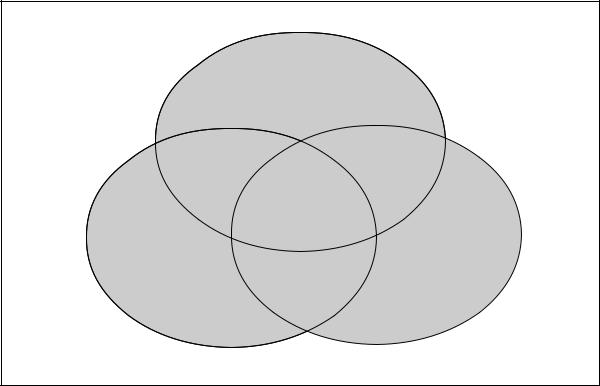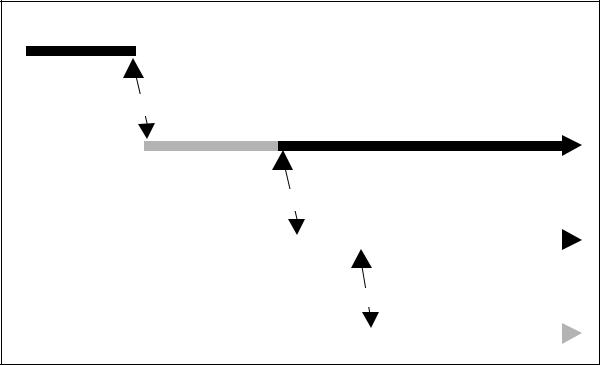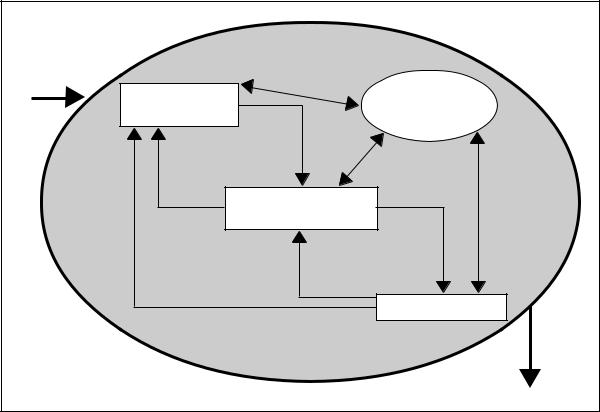
Диплом ИМЭ, ССК / Диплом / diplom / Приложения / HANDBOOK_DOD-Systems-Engineering-Guide-2001-01
.pdf
Introduction |
Systems Engineering Fundamentals |
SYSTEMS
ENGINEERING
FUNDAMENTALS
January 2001
SUPPLEMENTARY TEXT
PREPARED BY THE
DEFENSE ACQUISITION UNIVERSITY PRESS
FORT BELVOIR, VIRGINIA 22060-5565
i

Systems Engineering Fundamentals |
Introduction |
ii

Introduction |
Systems Engineering Fundamentals |
TABLE OF
CONTENTS
PREFACE ............................................................................................................................................. |
|
iv |
PART 1. INTRODUCTION |
|
|
Chapter 1. |
Introduction to Systems Engineering Management ............................................. |
3 |
Chapter 2. |
Systems Engineering Management in DoD Acquisition .................................... |
11 |
PART 2. THE SYSTEMS ENGINEERING PROCESS |
|
|
Chapter 3. |
Systems Engineering Process Overview ............................................................ |
31 |
Chapter 4. |
Requirements Analysis ....................................................................................... |
35 |
Chapter 5. |
Functional Analysis and Allocation .................................................................... |
45 |
Chapter 6. |
Design Synthesis ................................................................................................ |
57 |
Chapter 7. |
Verification ......................................................................................................... |
65 |
Chapter 8. |
Systems Engineering Process Outputs ............................................................... |
73 |
PART 3. SYSTEM ANALYSIS AND CONTROL |
|
|
Chapter 9. |
Work Breakdown Structure ................................................................................ |
85 |
Chapter 10. |
Configuration Management ................................................................................ |
91 |
Chapter 11. |
Technical Reviews and Audits ............................................................................ |
99 |
Chapter 12. |
Trade Studies .................................................................................................... |
111 |
Chapter 13. |
Modeling and Simulation ................................................................................. |
117 |
Chapter 14. |
Metrics .............................................................................................................. |
125 |
Chapter 15. |
Risk Management ............................................................................................. |
133 |
PART 4. PLANNING, ORGANIZING, AND MANAGING |
|
|
Chapter 16. |
Systems Engineering Planning ......................................................................... |
147 |
Chapter 17. |
Product Improvement Strategies ...................................................................... |
157 |
Chapter 18. |
Organizing and Integrating System Development ............................................ |
171 |
Chapter 19. |
Contractual Considerations .............................................................................. |
185 |
Chapter 20. |
Management Considerations and Summary ..................................................... |
201 |
GLOSSARY ..................................................................................................................................... |
|
209 |
iii

Systems Engineering Fundamentals |
Introduction |
PREFACE
This book provides a basic, conceptual-level description of engineering management disciplines that relate to the development and life cycle management of a system. For the non-engineer it provides an overview of how a system is developed. For the engineer and project manager it provides a basic framework for planning and assessing system development.
Information in the book is from various sources, but a good portion is taken from lecture material developed for the two Systems Planning, Research, Development, and Engineering courses offered by the Defense Acquisition University.
The book is divided into four parts: Introduction; Systems Engineering Process; Systems Analysis and Control; and Planning, Organizing, and Managing. The first part introduces the basic concepts that govern the systems engineering process and how those concepts fit the Department of Defense acquisition process. Chapter 1 establishes the basic concept and introduces terms that will be used throughout the book. The second chapter goes through a typical acquisition life cycle showing how systems engineering supports acquisition decision making.
The second part introduces the systems engineering problem-solving process, and discusses in basic terms some traditional techniques used in the process. An overview is given, and then the process of requirements analysis, functional analysis and allocation, design synthesis, and verification is explained in some detail. This part ends with a discussion of the documentation developed as the finished output of the systems engineering process.
Part three discusses analysis and control tools that provide balance to the process. Key activities (such as risk management, configuration management, and trade studies) that support and run parallel to the system engineering process are identified and explained.
Part four discusses issues integral to the conduct of a systems engineering effort, from planning to consideration of broader management issues.
In some chapters supplementary sections provide related material that shows common techniques or policy-driven processes. These expand the basic conceptual discussion, but give the student a clearer picture of what systems engineering means in a real acquisition environment.
iv

Chapter 1 |
Introduction to Systems Engineering |
PART 1
INTRODUCTION
1
Systems Engineering Fundamentals |
Chapter 1 |
2
Chapter 1 |
Introduction to Systems Engineering |
CHAPTER 1
INTRODUCTION TO
SYSTEMS ENGINEERING
MANAGEMENT
1.1 PURPOSE
The overall organization of this text is described in the Preface. This chapter establishes some of the basic premises that are expanded throughout the book. Basic terms explained in this chapter are the foundation for following definitions. Key systems engineering ideas and viewpoints are presented, starting with a definition of a system.
1.2 DEFINITIONS
A System Is …
Simply stated, a system is an integrated composite of people, products, and processes that provide a capability to satisfy a stated need or objective.
Systems Engineering Is…
Systems engineering consists of two significant disciplines: the technical knowledge domain in which the systems engineer operates, and systems engineering management. This book focuses on the process of systems engineering management.
Three commonly used definitions of systems engineering are provided by the best known technical standards that apply to this subject. They all have a common theme:
•A logical sequence of activities and decisions that transforms an operational need into a description of system performance parameters and a preferred system configuration. (MIL-STD-
499A, Engineering Management, 1 May 1974. Now cancelled.)
•An interdisciplinary approach that encompasses the entire technical effort, and evolves into and verifies an integrated and life cycle balanced set of system people, products, and process solutions that satisfy customer needs. (EIA Standard IS-632, Systems Engineering, December 1994.)
•An interdisciplinary, collaborative approach that derives, evolves, and verifies a life-cycle balanced system solution which satisfies customer expectations and meets public acceptability. (IEEE P1220, Standard for Application and Management of the Systems Engineering
Process, [Final Draft], 26 September 1994.)
In summary, systems engineering is an interdisciplinary engineering management process that evolves and verifies an integrated, life-cycle balanced set of system solutions that satisfy customer needs.
Systems Engineering Management Is…
As illustrated by Figure 1-1, systems engineering management is accomplished by integrating three major activities:
•Development phasing that controls the design process and provides baselines that coordinate design efforts,
•A systems engineering process that provides a structure for solving design problems and
3

Systems Engineering Fundamentals |
Chapter 1 |
Development
Phasing
Baselines |
|
Life Cycle |
|
|
Planning |
||
|
Systems |
||
|
|
||
|
Engineering |
|
|
|
Management |
|
|
Systems |
|
Life Cycle |
|
Engineering |
Integrated |
||
Integration |
|||
Process |
|||
Teaming |
|
||
|
|
Figure 1-1. Three Activities of Systems Engineering Management
tracking requirements flow through the design effort, and
•Life cycle integration that involves customers in the design process and ensures that the system developed is viable throughout its life.
Each one of these activities is necessary to achieve proper management of a development effort. Phasing has two major purposes: it controls the design effort and is the major connection between the technical management effort and the overall acquisition effort. It controls the design effort by developing design baselines that govern each level of development. It interfaces with acquisition management by providing key events in the development process, where design viability can be assessed. The viability of the baselines developed is a major input for acquisition management Milestone (MS) decisions. As a result, the timing and coordination between technical development phasing and the acquisition schedule is critical to maintain a healthy acquisition program.
The systems engineering process is the heart of systems engineering management. Its purpose is to provide a structured but flexible process that transforms requirements into specifications, architectures, and configuration baselines. The discipline of this process provides the control and traceability to develop solutions that meet customer needs. The systems engineering process may be repeated one or more times during any phase of the development process.
Life cycle integration is necessary to ensure that the design solution is viable throughout the life of the system. It includes the planning associated with product and process development, as well as the integration of multiple functional concerns into the design and engineering process. In this manner, product cycle-times can be reduced, and the need for redesign and rework substantially reduced.
1.3 DEVELOPMENT PHASING
Development usually progresses through distinct levels or stages:
4

Chapter 1 |
Introduction to Systems Engineering |
•Concept level, which produces a system concept description (usually described in a concept study);
•System level, which produces a system description in performance requirement terms; and
•Subsystem/Component level, which produces first a set of subsystem and component product performance descriptions, then a set of corresponding detailed descriptions of the products’ characteristics, essential for their production.
The systems engineering process is applied to each level of system development, one level at a time, to produce these descriptions commonly called configuration baselines. This results in a series of configuration baselines, one at each development level. These baselines become more detailed with each level.
descriptions, and the product baseline for the subsystem/component detail descriptions. Figure 1-2 shows the basic relationships between the baselines. The triangles represent baseline control decision points, and are usually referred to as technical reviews or audits.
Levels of Development Considerations
Significant development at any given level in the system hierarchy should not occur until the configuration baselines at the higher levels are considered complete, stable, and controlled. Reviews and audits are used to ensure that the baselines are ready for the next level of development. As will be shown in the next chapter, this review and audit process also provides the necessary assessment of system maturity, which supports the DoD Milestone decision process.
1.4 THE SYSTEMS ENGINEERING
In the Department of Defense (DoD) the configuration baselines are called the functional baseline for the system-level description, the allocated baseline for the subsystem/ componentperformance
PROCESS
The systems engineering process is a top-down comprehensive, iterative and recursive problem
Concept Studies
DESIGN DEFINITION
System Definiiton
(Functional Baseline)
DESIGN DEFINITION
Preliminary Design
(Allocated Baseline)
|
|
|
|
DESIGN |
DEFINITION |
Detail Design |
|
|
|
|
|
|
|
|
(Product Baseline) |
|
|
|
|
|
|
|
|
Figure 1-2. Development Phasing
5

Systems Engineering Fundamentals |
Chapter 1 |
solving process, applied sequentially through all stages of development, that is used to:
•Transform needs and requirements into a set of system product and process descriptions (adding value and more detail with each level of development),
•Generate information for decision makers, and
•Provide input for the next level of development.
As illustrated by Figure 1-3, the fundamental systems engineering activities are Requirements Analysis, Functional Analysis and Allocation, and Design Synthesis—all balanced by techniques and tools collectively called System Analysis and Control. Systems engineering controls are used to track decisions and requirements, maintain technical baselines, manage interfaces, manage risks, track cost and schedule, track technical performance, verify requirements are met, and review/audit the progress.
During the systems engineering process architectures are generated to better describe and understand the system. The word “architecture” is used in various contexts in the general field of engineering. It is used as a general description of how the subsystems join together to form the system. It can also be a detailed description of an aspect of a system: for example, the Operational, System, and Technical Architectures used in Command, Control, Communications, Computers, Intelligence, Surveillance, and Reconnaissance (C4ISR), and software intensive developments. However, Systems Engineering Management as developed in DoD recognizes three universally usable architectures that describe important aspects of the system: functional, physical, and system architectures. This book will focus on these architectures as necessary components of the systems engineering process.
The Functional Architecture identifies and structures the allocated functional and performance requirements. The Physical Architecture depicts the
P |
|
|
R |
|
|
O |
|
|
C |
|
|
E |
Requirements |
System Analysis |
S |
||
S |
Analysis |
and Control |
|
|
(Balance) |
I |
Requirements |
|
N |
Loop |
|
P |
|
|
U |
Functional Analysis |
|
T |
and Allocation |
|
|
|
|
|
|
Design |
|
|
Loop |
|
Verification |
|
|
|
Design Synthesis |
|
|
PROCESS OUTPUT |
Figure 1-3. The Systems Engineering Process
6
